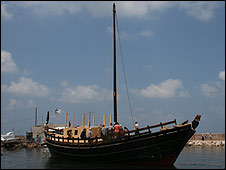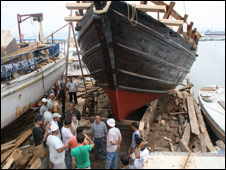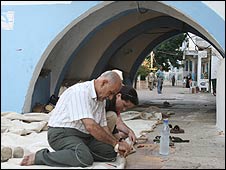|
Lina Sinjab
BBC News, Damascus
|

|

The
boat is entirely wooden and has only one sail
|
On
Arwad Island off the coast of Syria, a group of 20 sailors-to-be are
preparing for a voyage their captain believes has not been undertaken for two
and a half millennia.
They
plan to set off on Sunday on a journey that attempts to replicate what the
Greek historian Herodotus mentions as the first circumnavigation of Africa in
about 600BC.
Their
vessel, the small, pine-wood Phoenicia, is modelled on the type of ship the
Phoenician sailors he credited with the landmark voyage would have used.
The
Phoenicians lived in parts of modern day Lebanon, Syria and Israel from about
1200BC and are widely credited with being both strong seafarers and the first
civilisation to make extensive use of an alphabet.
Mammoth
project
Celebrating
Damascus as a capital of Arab Culture for the year 2008, event organisers
sponsored the British-run expedition project to mark their festivities.
The
year-long voyage will take the crew into some of the most dangerous waters in
the world.
As
well as sailing round the southern most tip of Africa, they are preparing to
deal with pirates and long periods of waiting for favourable winds.
The
skilful shipbuilders in Arwad are familiar with construction techniques
dating back 200-300 years, but shipbuilder Orwa Bader, 28, says this is the
first time they have ever tried to build in the Phoenician style.
"Usually
it takes three men and two months to build any type of ship. But this time,
we needed at least five to 10 builders to work on it over eight months to
make it ready. It was a hard but enjoyable job."
The
vessel, designed on the basis of information from wrecked ships, pottery and
other archaeological artefacts from the era, is made entirely of wood, with a
single sail and no engine.
The
only concession to 21st Century sailing equipment is its navigational system.
Its top speed will be the equivalent of 10km/h on land.
Piracy
fears
The
route goes through the Red Sea, past Somalia and down the East African cost
before rounding the southern tip of Africa around Christmas time.
|

The
vessel was designed from archaeological evidence
|
The
ship's skipper, Philip Beale, planned the voyage.
"The
most difficult part will be circumnavigating around the Cape of Good Hope
where many shipwrecks are testimony to the difficult conditions there. You
can get big waves of 20 metres or more there. It is a dangerous area and
we'll be there in December and January."
He
predicts they have a 70% chance of completing the voyage successfully.
"But
there's a 30% chance we make a serious navigational error or we come up
against pirates and we are kidnapped or something," he adds.
Few
luxuries
The
ship will be crewed by a largely British team of volunteers, some of whom
have never done anything similar. Living conditions will be tough, and little
different from those the Phoenicians would have endured.
The
experience will be new for John Bainbridge, 23: "It's about how you get
on with people. That's the most essential skill," he says.
|

Local
boatmakers said they had never done anything like it before
|
And
Julia Rouc, 26, originally from Zimbabwe, is hoping to spend time reading and
possibly continue developing her aspirations to become a professional artist.
"I
am excited about it. It is a great experience. I am used to living in tough
conditions so it is all fine by me. But I am not sure if I will have time to
continue painting."
Below
deck, it feels extremely hot. There will be no ventilation and no running
water, and one toilet for the 20 crew members. Their bunks are barely big
enough to lie in.
Unlike
the Phoenicians' ships, the vessel will be equipped with lifeboats, and will
carry large amounts of food and fresh water.
But
just like the ancient sailors, the crew will not really know how the boat
will fare until it hits the open sea.
|




